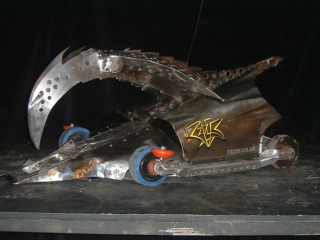|
|
|
Razer

The Creation of Razer
Razer came into being after Ian Lewis and
Simon Scott saw the first series of Robot Wars UK. Both of them had worked
on unusual mechanical and sculptural projects (some solo and some as a team) for
many years. With their engineering backgrounds, Ian's experience in
radio-controlled models, and Simon's hydraulic expertise, robotic combat was
certainly
tailor-made for them. Without being disrespectful to the pioneers of the UK
Wars, it was plain to see that there was room for plenty more destruction. From
the very start, Razer was designed to be a machine of ultimate offensive
capability.
The question now was - what style of weapon could totally disable the
opposition?
It was fairly obvious - half-decent armour would sustain little more than
scratches and dents from axes, hammers, disc grinders and drills. Lifting and
flipping devices are very useful, but if your adversary has a "srimech"
(self-righting
mechanism) then they are going to be coming back at you. Bearing in mind that
corrosives, explosives, lasers and the like are not permitted, Ian and Simon had
to decide on a mechanical method to inflict destruction. The one they
chose was based on the principle of the fly press, a factory device which is
used to bend and fold metal into shape by progressive force. If they could
harness enough power to use this as the weapon, then Razer would prove a MOST
devastating opponent. Mechanical means only, however, wouldn't create enough
sustainable force. Pneumatics, too, would be insufficient. Then hydraulics were
proposed (just think about the capabilities of a trolley jack). This system is
so effective that the power of a human arm could lift a car weighing two tonnes
or more! And so the weapon was therefore based on this principle.
After researching suitable components, it was finally decided that an hydraulic ram and pump powered by a motorbike starter motor would do the job. The central part of the chassis and the crushing arm were constructed first. Once these were complete, the rest of the chassis and the drives were added. It took the best part of three months of evenings and weekends for Ian and Simon to complete the first version of Razer, and it was finished literally the night before Robot Wars UK Series 2 began filming.
Modifications
Wings
After Series 2, it was apparent that Razer
would need to be modified in certain areas if it was to remain competitive.
There were now many powerful lifting and flipping machines, and if we got turned
turtle we were out. Ian and Simon had noticed that when the crushing arm was
fully raised the robot was already more than halfway to rolling back over and
they came up with the concept of extendable wings which would allow it to go all
the way back onto the wheels. These would be controlled by cables which would
tighten when the arm reached the top of its stroke, and so no separate motors
would be needed. The biggest problem was weight. Razer was already right on the
limit, and adding another few chunks of steel to it would send it all the way
over. To this end, Simon and Ian spent hours removing unneeded metal from every
conceivable area of the robot. In all, some 450 holes were drilled out!! It was
worth the effort - the wings of Razer have been used effectively many times in
battle and have been a major factor in our continued success.
Wheels
A further modification to Razer after Series 2
was to create new rear wheels. The four-wheeled drive system on Razer
means that it relies on skid steering to control the direction of the machine.
It is biased to swing the back end round, thus keeping the crushing arm pointed
at the opposition. This makes sense for offensive and defensive reasons. Solid
rubber wheels are not really good enough for this system as it takes a lot of
force to start the rear end turning, and once it does turn it keeps on going,
making accurate steering tricky. Ian and Simon decided to custom build new
wheels which incorporated rollers allowing sideward as well as forward motion.
The wheel frames were originally made of aluminium but kept buckling from
impacts. They have now been replaced with titanium (kindly supplied by Arthur
Chilcott from Mortis - cheers, Arfa!!!). The rollers are made of
polyurethane. This modification has greatly improved the control and has also
significantly reduced the power consumption.
Gyro
Despite the new wheels, Razer was now prone to
over steer and it was George Francis of Chaos 2 who told us how to overcome this.
The addition of a Hitec electronic gyro (commonly used on model helicopters)
would have a calming effect on the steering. The component costs about £35 and
is readily available from model shops. The results were excellent and we
would recommend this item to anyone with similar problems.
(Taken from the Official Razer website)